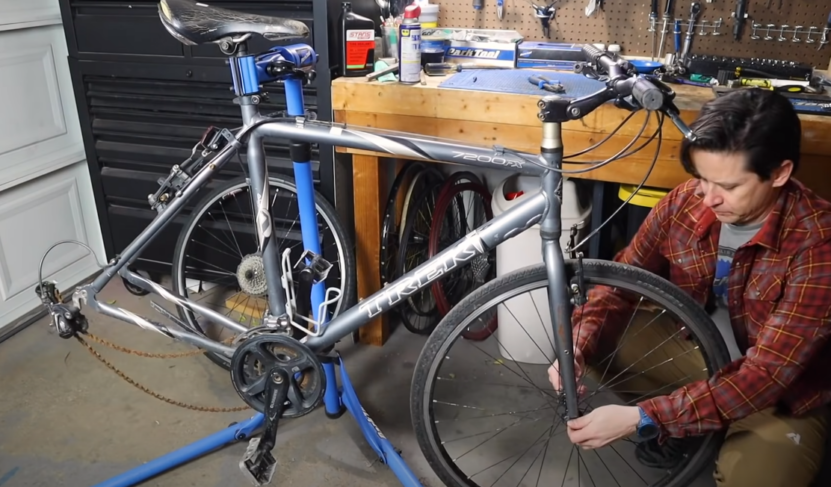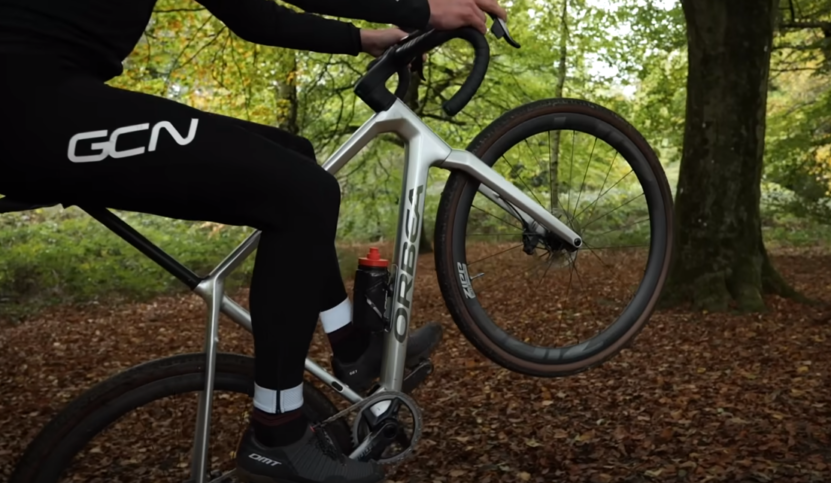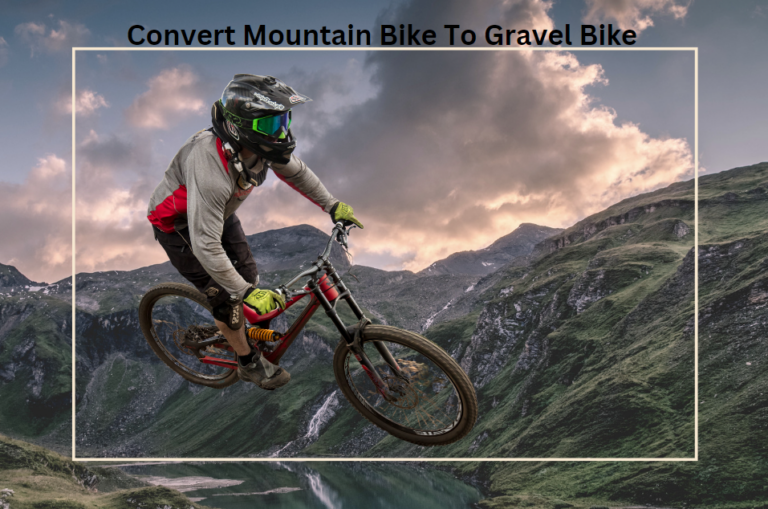Mountain biking is a great way to get outdoors and explore nature. However, sometimes your local trails can get a bit crowded.
If you’re looking for a way to escape the crowds and get off the beaten path, then converting your mountain bike into a gravel bike might be the perfect solution.
Gravel biking is a relatively new sport that is growing in popularity. It involves riding a bike on unpaved roads and trails, often in remote areas.
This type of riding can be challenging and adventurous, and it’s a great way to see some amazing scenery. Follow 5 Simple Steps to convert mountain bike to gravel bike.
Convert Moutain Bike To Gravel Bike

To add a little more versatility to your riding, or want to try something new, converting your mountain bike into a gravel bike is a great option. It’s not as difficult as it might sound, and with a few simple modifications, you can turn your MTB into a machine that’s capable of tackling all kinds of terrain.
Here’s what you’ll need to do:
1. Swap Out Your Tires:
The first step is to swap out your mountain bike tires for something a little more suited to gravel riding. There are a number of different options available, but we recommend something in the 35-45mm range. This will give you the added traction and cushioning you need for riding on rougher surfaces.
2. Adjust Your Saddle And Handlebars:
You’ll want to make sure your saddle is in a comfortable position for longer rides, and that your handlebars are at a good height for the control. This is especially important if you’re planning on doing any technical riding on gravel roads.
3. Get Some New Pedals:
Mountain bike pedals can be a bit slippery when wet, so it’s worth investing in a good pair of gravel-specific pedals. This will help you keep your feet planted on those long, grindy climbs.
4. Convert Your Brakes:
If your mountain bike has disc brakes, you’re all set. If not, you’ll need to swap out your brake pads and rotors for something that’s compatible with disc brakes. This is a pretty straightforward process, but make sure you get the right size pads and rotors for your bike.
5. Install Fenders:
Fenders are a must-have if you’re planning on riding in wet or muddy conditions. They’ll keep you and your bike clean, and help prevent any water or dirt from getting thrown up into your face.
With these few simple modifications, you can turn your mountain bike into a gravel-crushing machine. Just make sure to take it easy at first and get used to riding on different terrain before you start pushing your limits.
Gravel Bike Tyres

Gravel bike tyres are a versatile option for riders looking to tackle a variety of terrain. They typically feature a wider width than road bike tyres, and offer more grip and traction on loose surfaces.
There are a few things to consider when choosing gravel bike tyres, including width, tread pattern, and compound. Here’s a quick overview of each:
Width: Gravel tyres typically range from 30-60mm in width. The wider the tyre, the more grip, and stability it will offer. However, wider tyres are also heavier and can slow down your bike on paved surfaces.
Tread pattern: The tread pattern on your tyre should be matched to the type of terrain you’ll be riding on. If you’re mostly riding on paved roads, a smooth-tread tyre is a good option. For more off-road riding, tyres with deeper tread patterns will offer more grip on loose surfaces.
Compound: The compound of your tyres is the material that they’re made from. Different compounds offer different levels of grip, durability and rolling resistance. Softer compounds offer more grip but wear down faster, while harder compounds last longer but don’t offer as much traction.
Gravel Bike Wheels
Gravel bike wheels are designed to provide a balance of speed, durability and comfort on all types of terrain. The best gravel bike wheels will be able to tackle a variety of riding conditions, from smooth tarmac to rough and uneven surfaces.
There are a few things to consider when choosing the right gravel bike wheels for your needs. Firstly, you need to decide what type of terrain you’ll be riding on most often.
If you’re mostly riding on smoothly paved roads, then you’ll need a wheelset with a higher spoke count for added strength and durability.
However, if you’re planning on tackling more challenging off-road trails, then a lower spoke count wheel will be lighter and easier to maneuver.
The next thing to consider is the width of your tires. Gravel bike tires are typically wider than road bike tires, so you’ll need a wider rim to accommodate them. Wider rims also provide a more comfortable ride, as they help to smooth out bumps and vibrations.
Finally, you need to decide on the right axle configuration for your bike. Most gravel bikes come with either quick release or thru-axle wheels. Quick-release wheels are easier to remove and install, but thru-axle wheels offer a more secure connection and are less likely to come loose during riding.
Gravel Bike Gears
Gravel bike gears are typically a bit different than those found on a road bike. Most notably, gravel bikes tend to have a wider range of gears, which can be helpful when riding over varied terrain. Additionally, many gravel bikes feature disc brakes, which offer more stopping power and can be helpful in wet or muddy conditions.
Choosing the right gears for your gravel bike, it’s important to consider the type of riding you’ll be doing most often. If you’re mostly riding on flat or rolling terrain, you probably won’t need as many gears as someone who frequently rides in hilly or mountainous areas.
Additionally, if you’re mostly riding on paved roads, you might not need the same range of gears as someone who frequently rides on unpaved trails. Ultimately, it’s important to choose a gear setup that will work well for the type of riding you do most often.
Gravel Bike Handlebar And Bar Tape
Gravel bike handlebars and bar tape are important components of your bike that can make a big difference in your comfort and performance. Here’s what you need to know to choose the best ones for your needs.
The first thing to consider when choosing gravel bike handlebars is the width. Handlebars come in a range of widths from 36cm to 46cm.
The width you choose will depend on your riding style and the kind of terrain you’ll be riding on. For example, if you’re mostly riding on singletrack trails, a narrower handlebar will give you more control. But if you’re planning on doing some long-distance road riding, a wider handlebar will give you more stability.
Next, you’ll need to decide on the material of the handlebar. Gravel bike handlebars are typically made from either aluminum or carbon fiber.
Carbon fiber is lighter and stronger than aluminum, but it’s also more expensive. If weight is a major concern for you, then carbon fiber is the way to go. But if you’re on a budget, aluminum is a perfectly good option.
Finally, you’ll need to choose the right bar tape for your gravel bike handlebars. The bar tape comes in a variety of colors and textures, so you can choose something that matches your bike’s color scheme.
Some bar tapes are designed to provide extra grip, while others are softer and more comfortable. Ultimately, it’s a matter of personal preference. Just make sure you choose a tape that’s compatible with your handlebars.
Gravel Bike Pedals

Gravel bike pedals are a type of mountain bike pedal that is designed for use on rough terrain. They are typically made from metal or plastic and have a wide, flat surface area to provide traction and stability when riding on loose surfaces.
Gravel bike pedals are available in a variety of different styles and designs, so it is important to choose the right pedal for your riding style and needs.
If you are planning on doing any serious off-road riding, then you will need a pedal that is durable and can withstand the rigors of the trail. However, if you just want to use your gravel bike for leisurely rides on gentle terrain, then a less rugged pedal will suffice.
Choosing gravel bike pedals, it is also important to consider the type of cleats that you will be using. Some pedals are designed for use with specific types of cleats, so make sure that you select a pedal that is compatible with the cleats that you have.

